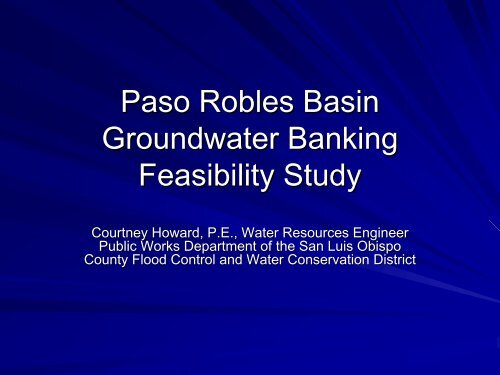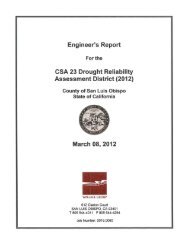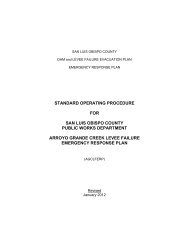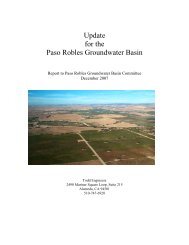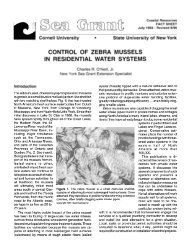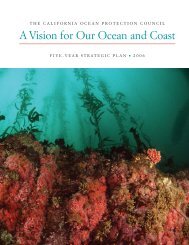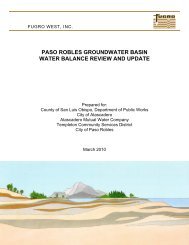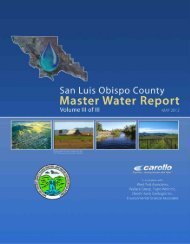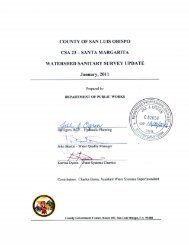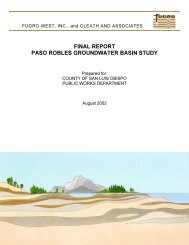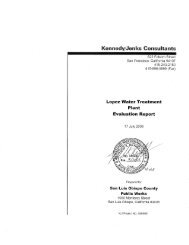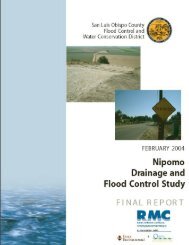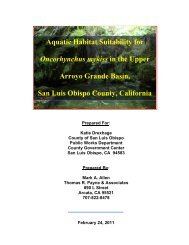Paso Robles Basin Groundwater Banking Feasibility Study
Paso Robles Basin Groundwater Banking Feasibility Study
Paso Robles Basin Groundwater Banking Feasibility Study
Create successful ePaper yourself
Turn your PDF publications into a flip-book with our unique Google optimized e-Paper software.
<strong>Paso</strong> <strong>Robles</strong> <strong>Basin</strong><br />
<strong>Groundwater</strong> <strong>Banking</strong><br />
<strong>Feasibility</strong> <strong>Study</strong><br />
Courtney Howard, P.E., Water Resources Engineer<br />
Public Works Department of the San Luis Obispo<br />
County Flood Control and Water Conservation District
<strong>Groundwater</strong> <strong>Banking</strong> <strong>Feasibility</strong> <strong>Study</strong><br />
Purpose of <strong>Study</strong><br />
Scope of <strong>Study</strong><br />
Potential results<br />
<strong>Groundwater</strong> banking<br />
methods and<br />
examples
Excess State Water Allocation<br />
Using 4,830 AFY of 25,000 AFY<br />
Allocation<br />
Contracts with State expire in year<br />
2035<br />
District needs to show “beneficial<br />
use” of the supply in order to<br />
maintain ownership<br />
<strong>Groundwater</strong> <strong>Banking</strong> may be an<br />
option<br />
Financial opportunity through<br />
IRWM Grant<br />
Coastal Branch of SWP<br />
Big Pipe In<br />
Little Pipe Out<br />
Polonio<br />
WTP
<strong>Groundwater</strong> <strong>Banking</strong> <strong>Feasibility</strong> <strong>Study</strong><br />
Can San Luis Obispo County utilize<br />
excess State Water allocation through a<br />
<strong>Groundwater</strong> <strong>Banking</strong> Plan?<br />
Is there a <strong>Groundwater</strong> <strong>Banking</strong> Plan that<br />
will be a win-win?<br />
win?<br />
Who might participate?<br />
Who might benefit?
<strong>Groundwater</strong> <strong>Banking</strong> <strong>Feasibility</strong> <strong>Study</strong><br />
IRWM Grant Agreement<br />
‣Water available for banking<br />
‣<strong>Study</strong> of site and options<br />
‣Stakeholder and Regulatory<br />
review<br />
‣Results, Conclusions, Next<br />
Steps<br />
Community Input
Three Steps of <strong>Groundwater</strong><br />
<strong>Banking</strong> Studies<br />
Step 1 – Data Collection and Hydrogeology <strong>Study</strong><br />
(<strong>Paso</strong> <strong>Groundwater</strong> <strong>Basin</strong> <strong>Study</strong> and Model)<br />
Step 2 – Methods Analysis and Layout<br />
Step 3 – Institutional, Legal and Financial Analysis<br />
Other steps follow if implementation is desired
Initiate <strong>Groundwater</strong><br />
<strong>Banking</strong> <strong>Feasibility</strong> <strong>Study</strong><br />
Quantity of Water Available<br />
Siting <strong>Study</strong><br />
Stakeholder and Regulatory Input<br />
Pass/Fail Criteria:<br />
•Physically Possible?<br />
•Impacts?<br />
•Financially Viable?<br />
Etc<br />
Feasible:<br />
Summary<br />
of next steps<br />
Not Feasible:<br />
Potential for<br />
feasibility in the<br />
future
Potential Results<br />
Not Feasible:<br />
Thoroughly assessed as an option<br />
Focus on other options<br />
Feasible:<br />
Water Supply Improvement<br />
Regional Cooperation
Methods to Bank Water in the Ground<br />
• In-Lieu Recharge<br />
Water is stored by substituting<br />
surface water for an equal<br />
amount of groundwater which<br />
would otherwise be pumped<br />
• Direct Recharge<br />
Water is stored by<br />
percolating or injecting<br />
directly to basin
Alternatives Analysis<br />
Increase in reliability<br />
Potential benefits for overlying users<br />
Losses (typically defined in contract), reduced pumping depth<br />
Infrastructure and costs<br />
Potential harm to overlying users<br />
CEQA – significant impact guideline - “pre-existing existing nearby wells would<br />
drop to a level which would not support existing land uses or planned<br />
uses for which permits have been granted” (Sec 15092, App. G)
Examples of Contractual Provisions<br />
Monitoring committee<br />
to determine what the<br />
“no project” condition<br />
would have been<br />
Define a limit when<br />
pumping will be<br />
curtailed<br />
Semitropic Bank and<br />
Kern Water Bank
Examples of Contractual Provisions<br />
Based on modeling<br />
Establish a “rule” to scale<br />
back pumping based on<br />
objective facts at the time<br />
of pumping, such as<br />
number of years and<br />
quality of water recently<br />
pumped and other water<br />
supplies of banker<br />
Arvin—MWD Program
Next Steps<br />
Develop scope of work - request for<br />
proposals<br />
Continue holding meetings<br />
Gather questions to include in study or to<br />
address if found feasible<br />
Complete study by January 2008<br />
www.SLOCountyWater.org<br />
Integrated Regional Water Management
Thank You!<br />
www.SLOCountyWater.org<br />
Integrated Regional Water Management<br />
Contact: Courtney Howard, 781-1016<br />
1016


